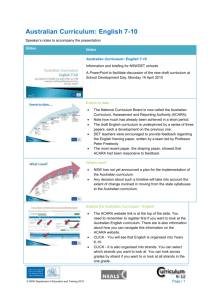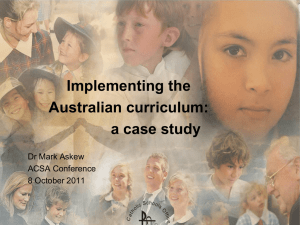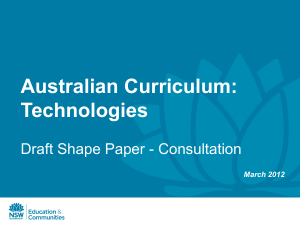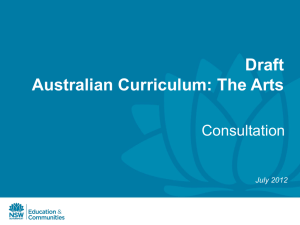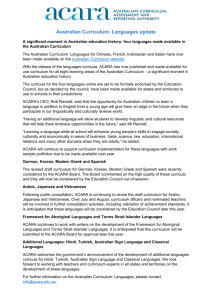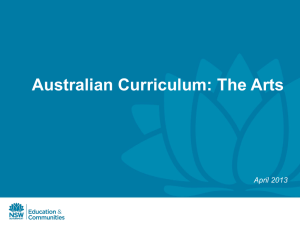Australian curriculum Mathematics K-6
advertisement
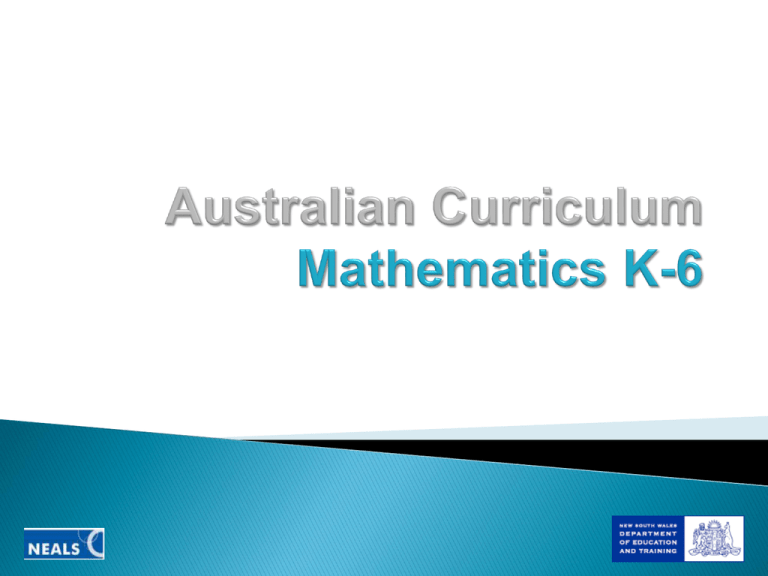
April 2008: National Curriculum Board established Nov 2008 Feb 2009: Consultation re mathematics framing paper May 2009: Writing of national mathematics curriculum commences I March 2010: Draft of national mathematics K-10 curriculum available for consultation March - May 2010: National consultation on mathematics curriculum I March 2010: draft K-10 Draft of Apr – June Australian 2010: mathematics 11-12 K-10 curriculum August 2010: Australian mathematics curriculum K-10 published October 2010: 11-12 Jan 2011: Implementation of mathematics curriculum commences from this month 2013 ACARA says implementation should be “well under way” by 2013 Mathematics K-6, 7-10 Draft Australian curriculum Content strands Number (includes Chance) Patterns and algebra Measurement Space and geometry Data Working Mathematically Questioning Applying Strategies Communicating Reflecting Reasoning Content strands Number and algebra Measurement and geometry Statistics and probability Proficiency strands Understanding Fluency Problem solving Reasoning Draft Consultation version 1.0.1 Australian Curriculum, ACARA, March 2010 Draft Consultation version 1.0.1 Australian Curriculum, ACARA, March 2010 Draft Consultation version 1.0.1 Australian Curriculum, ACARA, March 2010, Curriculum for a particular year Content descriptions organised into strands Content elaborations Achievement standards Resources General capabilities Cross-curriculum perspectives Work samples In general, similar content Both contain process and content strands General capabilities: Literacy, Numeracy, Information and Communication Technology, Thinking skills, Creativity Much of the content appears in different years to our syllabus Content sequencing Content descriptions are brief and sometimes rely on the elaborations for meaning The achievement standard for Kindergarten The language of problem types Increased difficulty of fractions Stronger emphasis on calculator use No description of standard subtraction algorithms Omissions. Does the draft Australian mathematics curriculum support both excellence and equity? Is the draft curriculum focused on the important ideas? Is the draft curriculum coherent? In particular, does the sequence of development make sense in number, geometry, etc? Is the draft curriculum internally consistent in the way it uses concepts from other strands? How does the draft curriculum provide support for the full range of students in your class? How do the standards compare to the current NSW syllabus? How does content organised in school years assist the diverse range of learners? How will teachers use the Australian curriculum to address the needs of particular groups of students? Will they need support to do this? ◦ Aboriginal and Torres Strait Islander students ◦ ESL students ◦ Students with learning difficulties ◦ Students with disabilities ◦ Gifted and talented students ◦ Others? Will teachers need professional learning and teaching resources to support the extra content in the Statistics and probability strand? With calculators being part of the mandatory content, how will primary schools provide all students with access to calculators? Will teachers need professional learning and teaching resources to support the introduction of this technology? Is any other support required for implementation? To register for the forum: http://currk12.janison.com/curriculum/register/register.htm If you have any problems with registering please contact Chris Dorbis via email or telephone 98867496. If you have been issued a password, please click on the following link to enter the forum. To enter the forum: http://currk12.janison.com/toolbox/desktop/logon.asp The latest version of the Australian mathematics curriculum and this PowerPoint are available in the forum. Teachers may also choose to share their views about the draft Australian mathematics curriculum via: ◦ Mathematics Association of NSW (MANSW) http://www.mansw.nsw.edu.au/ ◦ NSW Board of Studies http://www.boardofstudies.nsw.edu.au/ or directly with ACARA http://www.acara.edu.au/home_page.html
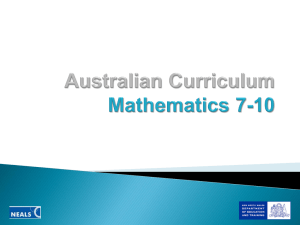
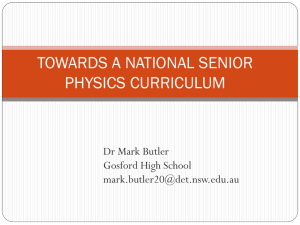
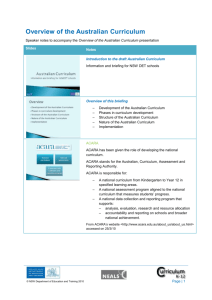
![qsa_pres_aus_curic_parents[1]](http://s2.studylib.net/store/data/005362756_1-02970dbc22ec3a3e28f8748c2e8fe2bd-300x300.png)

